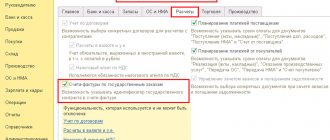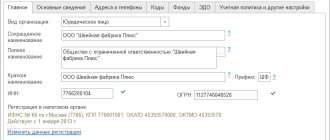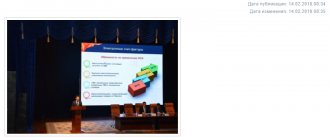Changes from 2021 and features of transitional provisions
If the parties have agreed to sell a consignment of goods subject to receipt of an advance payment from the buyer, the seller is obliged to charge value added tax upon receipt in accordance with the current rate at a given time.
That is, for an advance payment received in 2021, it was necessary to proceed from the current rate of 18%, and if the advance was paid in 2021, then a rate of 20% should now be applied.
Once the money has been paid, the tax payment should occur on the same day. In this case, the date of shipment will not matter. This is regulated by subparagraph 2 of paragraph 1 of Article 167 of the Tax Code of the Russian Federation.
After delivery of the goods, VAT must be calculated based on the rate in effect at the time of shipment of the goods. However, we must remember that part of the tax was accrued upon receipt of the advance payment. Now you need to file the remaining tax.
From the beginning of 2021, the value added tax rate has been changed. This was done on the basis of Federal Law No. 303 dated August 3, 2018. An important question is at what rate it is necessary to ship goods, an advance payment for which was paid in the previous year.
For the transition period, the following rule applies. If the delivery of a batch of goods occurs in 2021, then the corresponding value added tax rate will be equal to 20%, despite the fact that with advance payment it was 2% less.
What is an advance payment for transactions subject to VAT?
According to the Civil Code of the Russian Federation, Art. 487, clause 1 prepayment (advance payment) will be payment received before the goods (services, work) were actually shipped to the buyer, and he, in turn, documented it for accounting.
Payments towards future deliveries will be considered in advance even if:
- payment was made in non-cash form (according to the Plenum of the Supreme Arbitration Court of the Russian Federation No. 33 dated May 30, 2014, paragraph 15; Letter of the Ministry of Finance of the Russian Federation No. 03-07-15/39 dated 0603.2009).
- payment was transferred on behalf of the seller to the accounts of third parties (the seller did not actually receive this amount of money).
Rules for calculating VAT obligations from advances received
To calculate value added tax liability, the following rules apply.
If this product is paid at a rate of 20%, then when calculating, the amount of funds received in advance is multiplied by 20 and divided by 120. The resulting figure is the amount of tax obligations associated with receiving an advance payment.
In some cases, the VAT rate may be 10%. In this situation, the amount of money received is multiplied by 10, then divided by 110. The result will be the tax liability associated with receiving the payment.
For advance payments received in 2021, the amount is multiplied by 18 and divided by 118. The resulting result reflects the amount of liabilities received.
Issuing an invoice for advance payment
The registration procedure is determined by Decree of the Government of the Russian Federation No. 1137 of December 26, 2011. Please note that registration must be done on a special form.
The document is filled out as follows:
- Lines 3 and 4 require a dash.
- Line 5 requires the number and date of the payment document.
- Lines 2 to 6 are marked with dashes.
- In line 7 you must indicate the tax rate in effect at the time of registration.
- Line 8 contains the tax amount.
- The amount of the prepayment is recorded in line 9.
- Lines 10 and 11 must contain a dash.
Receiving advance payment from the buyer in 1C: Accounting 8 edition 3.0
To perform operation 2.1 “Accounting for advance payment from the buyer”, based on the document Invoice to the buyer (Fig. 1), a document Receipt to the current account is created with the transaction type “Payment from the buyer”.
Indicators of the document Receipt to the current account
are filled in automatically based on the information in the
Buyer Invoice
.
In addition, in the document Receipt to current account
must be indicated (Fig. 2):
- in the fields According to document No.
and
from
– the number and date of the buyer’s payment order; - in the Amount
– the actual amount of the transferred prepayment.
Rice. 2
As a result of posting the document Receipt to the current account
An accounting entry will be generated (Fig. 3):
- on the debit of account 51 and the credit of account 62.02 - for the amount of funds received by the seller from the buyer.
Rice. 3
In accordance with paragraph 3 of Art. 168 of the Tax Code of the Russian Federation, the buyer of goods who has transferred the prepayment amount must be issued an invoice no later than 5 calendar days, counting from the date of receipt of the prepayment.
An invoice for the received prepayment amount (operation 2.2 “Creating an invoice for the amount of prepayment”; 2.3 “Calculation of VAT on the received prepayment”) in the program is generated on the basis of the document Receipt to the current account using the Create
(Fig. 2).
Automatic generation of invoices for advances received from customers can also be done using the processing “Registration of invoices for advances” (section Banks and cash desk
).
In the new document Invoice issued
(Fig. 4) basic information will be filled in automatically according to the base document:
- in the from
– the date of preparation of the invoice, which by default is set to the same date as the date of generation of the document
Receipt to the current account
; - in the fields Counterparty
,
Payment document No.
and
from
- the relevant information from the basis document; - in the Invoice type
– the value
For advance
; - in the tabular part of the document - the amount of the received prepayment, the VAT rate and the VAT amount, respectively.
In addition, the following will be automatically entered:
- in the Transaction type code
– value 02, which corresponds to payment, partial payment (received or transferred) on account of upcoming deliveries of goods (work, services), property rights (appendix to the order of the Federal Tax Service of Russia dated March 14, 2016 No. ММВ-7-3/ [email protected] ); - Compiled
switch is set to
On paper
, if there is no valid agreement on the exchange of electronic invoices, or
In electronic form
, if such an agreement has been concluded; - Issued (transferred to the counterparty)
checkbox indicating the date, if the invoice is transferred to the buyer and is subject to registration. If there is an agreement on the exchange of electronic invoices before receiving confirmation from the EDI operator, the checkbox and date of issue will be absent. If the date of transfer of a paper invoice to the buyer is different from the date of preparation, then it must be adjusted; - The Manager
and
Chief Accountant
fields are data from the “Responsible Persons” information register.
If the document is signed by other responsible persons, for example, on the basis of a power of attorney, then it is necessary to enter the relevant information from the directory Individuals
.
For the correct preparation of an invoice, as well as the correct reflection of the document in the accounting system, it is necessary that in the Nomenclature
the tabular part of the document indicated the name (or generic name) of the goods supplied in accordance with the terms of the agreement with the buyer.
This information is filled in automatically indicating:
- names of specific product items from the document Invoice to the buyer
(Fig. 1), if such an invoice was previously issued; - a generic name, if such a generic name was defined in the agreement with the buyer.
Rice. 4
Click the Print document button. Invoice issued
(Fig. 4) you can go to view the invoice form and then print it in two copies (Fig. 5).
According to the Rules for filling out an invoice, approved. By Decree of the Government of the Russian Federation dated December 26, 2011 No. 1137, the invoice for the prepayment amount received indicates:
- in line 5 – details (number and date of preparation) of the payment and settlement document (clause “h” of clause 1 of the Rules for filling);
- in column 1 – the name of the goods supplied (description of work, services), property rights (clause “a”, clause 2 of the Filling Rules);
- in column 8 - the amount of tax calculated on the basis of the tax rate determined in accordance with clause 4 of Art. 164 of the Tax Code of the Russian Federation (clause “z”, clause 2 of the Rules for filling);
- in column 9 – the amount of advance payment received (clauses “and” clause 2 of the Filling Rules);
- in lines 3 and 4 and columns 2–6, 10–11 – dashes (clause 4 of the Filling Rules).
Rice. 5
As a result of posting the document Invoice issued
An accounting entry is generated (Fig. 6):
- on the debit of account 76.AB and the credit of account 68.02 - for the amount of VAT calculated from the received advance payment from the buyer in the amount of RUB 27,000.00. (RUB 177,000.00 x 18/118).
Rice. 6
Based on the document Invoice issued
an entry is made in the information register
of the Invoice Log
(Fig. 7).
Despite the fact that since 01/01/2015, taxpayers who are not intermediaries (forwarders, developers) do not keep a log of received and issued invoices, the entries in the “Invoice Log” register are used to store the necessary information about the issued invoice - invoice.
Rice. 7
Document Invoice issued
is registered in the accumulation register “VAT Sales” (Fig. 8).
Rice. 8
Based on the entries in the “VAT Sales” register, a sales book is generated for the fourth quarter of 2021 (Section Sales - VAT subsection
) (Fig. 16).
The amount of VAT accrued from the prepayment received is reflected on line 070 of section 3 of the VAT tax return for the fourth quarter of 2018 (approved by order of the Ministry of Finance of Russia dated October 15, 2009 No. 104n) (section Reports
– subsection
1C-Reporting
– hyperlink
Regulated reports
).
Adjustments related to carryover advances in 2021
If there is a need to return a previously received prepayment, then the VAT adjustment occurs in the amount in which the tax was accrued.
Let the funds be transferred in 2021, and in January they needed to be returned, then the VAT adjustment occurs when an adjustment invoice is provided. The amount is equal to the previously accrued tax at the rate of 18%.
If the prepayment was paid in 2021 and the supply is made in 2021, then the remaining tax liability accrues on the day the supply is made.
In cases where several partial shipments are made, VAT is taken into account in accordance with the tax rules in force at that time.
If, upon the next partial delivery, the total VAT obligations exceed those that arose when transferring the prepayment, then the remaining part is registered as a tax liability.
The calculation occurs in a similar way when the goods are delivered in 2021.
If the amount of the prepayment exceeds the cost of the full delivery, then the amount of the previously accrued tax actually exceeds the obligations following the transaction. In this case, excess VAT is not deductible.
If the goods were shipped last year, but in 2021 there was a price adjustment for it, then this is done on the basis of an adjustment invoice based on the rate that was in effect on the date of shipment (in this case we are talking about 18%).
VAT recovery on advances received is carried out by the buyer. This is done in two cases:
- A consignment of goods was delivered for which an advance payment was given.
- The deal was canceled and the advance payment was returned.
When a delivery is made, the buyer is subject to a VAT deduction. At the same time, previously, when paying the advance payment, a deduction was also provided. Now it is subject to restoration, that is, liabilities increase by the same amount. A similar situation arises when returning money.
How to calculate VAT for an advance payment in 2021
The law also applies to the taxpayer when he may not calculate the amount of VAT on the advance payment. This happens when he:
- Sells products that are subject to a 0% export rate.
- Sells goods whose production time is more than 6 months. This list is approved by the government of the Russian Federation.
- Sells products that are tax free. In this case, tax is not charged upon shipment.
- Sells goods outside the Russian Federation. In this case, the goods are not subject to tax.
Upon receipt of an invoice from a supplier, the buyer’s accountant generates the following entries:
- 1 transaction – the advance payment to the supplier has been paid.
- 2 entry – the amount of VAT on the advance payment.
- Posting 3 - the amount of goods received.
- 4 entry – input tax, which goes to deduction.
- Posting 5 – restoration of advance VAT.
Recently, many entrepreneurs and enterprises have been working under prepayment contracts. When receiving an advance payment, the supplier has a lot of obligations. They concern not only contractual obligations, but also the allocation of VAT and the payment of advance taxes to the budget.
Often an accountant has a question about how to deduct VAT from advances received.
The tax is charged both upon shipment of goods and upon receipt of an advance payment. But double VAT does not occur, since the company has the right to deduction.
When the advance payment occurred, the recipient organization had obligations to the client. The supplier must ship the goods to the client within five working days, unless otherwise specified in the contract.
The amount of VAT itself is calculated from the tax rate on the product. It can be 10%, but more often it is 18%. An invoice is issued for the advance amount, which is subsequently sent to the buyer. Advance accruals occur in stages as follows:
- Based on NK 168, an invoice is issued within five working days.
- The invoice is recorded in the sales ledger.
- VAT is calculated at a certain rate for goods (10% or 18%).
Using an example, you can see how this happens technically.
They indicate that an advance payment was received from the buyer on the basis of supply agreements.
24.10.2018
- VAT was calculated on the advance received at the rate of 18/118 - in the amount of 18,000 rubles. (118,000: 118 x 18).
15.01.2019
- VAT on sales was calculated and presented to the buyer at a rate of 20% - in the amount of RUB 19,666.67. (118,000: 1.20 x 20%).
- accepted for deduction of VAT on advances in the amount of 18,000 rubles. – as calculated in 2021.
24.10.2018
- accepted for deduction of VAT on advances issued at the rate of 18/118 - in the amount of 18,000 rubles. (118,000: 118 x 18).
15.01.2019
- Input VAT was accepted for deduction at a rate of 20% - in the amount of RUB 19,666.67. (118,000: 1.20 x 20%);
- VAT on advances in the amount of 18,000 rubles was restored in the sales book. – how they were accepted for deduction in 2021.
Accounting with the Seller
20.11.2018
- VAT was calculated on the advance received at the rate of 18/118 - in the amount of 18,000 rubles. (118,000: 118 x 18).
25.12.2018
- an adjustment SF was drawn up for the advance received on November 20, 2018: changed: the amount of VAT is 18,305.08 rubles, the cost of services is only 120,000 rubles; tax rate 18/118 – unchanged;
- increase: tax 305.08 rubles, cost of services 2,000 rubles.
27.05.2019
- VAT on sales is calculated and presented to the buyer at a rate of 20% - in the amount of 20,000 rubles. (120,000: 1.20 x 20%);
- accepted for deduction of VAT on advances in the amount of RUB 18,305.08. – taking into account the adjustment SF issued on December 25, 2018.
The difference between the cost amounts and VAT is reflected
- page 070 Section 3: gr. 3 – 2,000 rub.
- gr. 5 – 305.08 rub.
Calculation of “delta” by cost and tax:
- 120,000 – 118,000 = 2,000 rubles. and 18,305.08 – 18,000 = 305.08 rubles.
The buyer paid additional cost
The preferential VAT rate of 10% will remain in 2021. Therefore, organizations that sell goods subject to VAT at a rate of 10% will apply the tax in the same manner.
Also, the changes will not affect the 0% VAT rate for transactions specified in Art. 164 of the Tax Code of the Russian Federation, in particular, when selling goods for export and providing international transportation services.
Supplier: if goods (works, services) are sold in 2021, and payment is received in 2021, then VAT must be charged in 2021 at a rate of 18%. When receiving payment in 2021, there is no need to adjust the VAT amount previously presented to the buyer. Starting from January 1, 2021, sales are carried out at a rate of 20%.
Buyer: if goods (work, services) are received from a supplier in 2021 and paid for in 2021, then input VAT is deductible at a rate of 18%. All subsequent payments for goods (work, services) received are based on the VAT rate in effect at the time of shipment and reflected by the supplier in the invoice.
For further sales in 2021 and later of the specified goods purchased in 2021, input VAT is deductible, as stated above, at a rate of 18%. Starting from January 1, 2019, VAT on sales is charged at a rate of 20%.
Supplier: if in 2021 a 100% prepayment is received for the sale of goods (works, services), which will take place in 2021, then VAT on the advance received in 2021 is charged at the calculated rate of 18/118. The same amount of VAT in 2021 is accepted for deduction when selling goods (works, services), which occurs at a VAT rate of 20%.
If in 2021 a partial prepayment is received for the sale, which will take place in 2021, then VAT on the advance received in 2018 is accrued for payment at the calculated rate of 18/118. When selling goods (works, services) in 2021 at a rate of 20%, VAT on a partial advance in the amount calculated at the rate of 18/118 is deductible.
Buyer: if goods (work, services) are fully paid for in 2018 and received in 2021, then VAT on the advance payment issued in 2018 is deductible at the calculated rate of 18/118. In 2021, after goods (works, services) are accepted for accounting, VAT from a previously paid advance is restored at the calculated rate of 18/118 based on the supplier’s advance invoice, VAT is accepted for deduction at a rate of 20% based on the invoice issued by the supplier at implementation.
If goods (work, services) are partially paid for in 2021 and received in 2021, then VAT on the amount of the partially paid advance in 2018 is deducted at the calculated rate of 18/118. In 2019, after goods (works, services) are accepted for accounting, VAT on a partially paid advance is restored in the amount in which it was previously accepted for deduction and, based on the supplier’s invoice for sales, VAT is accepted for deduction at a rate of 20%.
Letter of the Federal Tax Service of Russia dated October 23, 2018 No. SD-4-3/ “On the procedure for applying the VAT tax rate during the transition period.”
Example: a contract concluded in 2021 stipulates that the buyer in 2021 pays an advance in the amount of 50% of the contract amount. The cost of goods (work, services) in accordance with the contract is 118,000 rubles, including VAT 18%. The parties signed an additional agreement to the contract, providing for the preservation of the cost of goods (work, services) without VAT and an increase in the amount of VAT due to changes in the rate. As a result, the final amount of the contract changed to 120,000 rubles, including VAT.
59,000 x 18/118 = 9,000 ₽.
The buyer deducts VAT in the amount of RUB 9,000 based on the supplier's advance invoice.
In 2021, when selling goods (works, services) using a VAT rate of 20%, the total sales amount is 120,000 rubles, including VAT 20,000 rubles.
The supplier charges VAT on sales in the amount of 20,000 ₽ and at the same time deducts VAT on the previously received advance in the amount of 9,000 ₽.
The buyer deducts VAT in the amount of 20,000 rubles based on the supplier's invoice for sales and at the same time restores the payment of VAT from the previously issued advance in the amount of 9,000 rubles.
As a result, the buyer must pay an additional 61,000 rubles (120,000 – 59,000 rubles) to the supplier in 2021.
If in 2021 the supplier sold goods (works, services) subject to VAT at a rate of 18% and issued an invoice to the buyer, and in 2021 the parties agreed to change their price or quantity, then the VAT rate is indicated in the adjustment invoice, valid on the date of sale, that is, 18%.
If in 2021 the supplier sold goods (works, services) subject to VAT at a rate of 18% and issued an invoice to the buyer, and in 2021 a technical error was discovered in this invoice, then the supplier issues a corrected invoice with the VAT rate, indicated on the original invoice, i.e. 18%.
Please note: in situation 5 we are talking only about services provided by foreign performers in electronic form, and not about all services.
Services provided in electronic form, for example, include advertising services on the Internet and the provision of advertising space on the Internet (for the list of services, see Article 174.2 of the Tax Code of the Russian Federation).
Services provided electronically do not include:
- sale of goods (work, services), if they are ordered via the Internet, but delivered (performed) without using the Internet (for example, by mail, courier);
- implementation (transfer of rights to use) computer programs, databases on tangible media (disks, flash drives);
- consulting services provided via email (correspondence);
- Internet access.
When paying an advance to a foreign supplier in 2021, the tax agent calculates VAT at the rate of 18/118. After accepting works (services) for accounting on the basis of documents received from a foreign supplier, the tax agent has the right to deduct VAT.
If the final settlement with a foreign supplier is made after receiving the results of work performed (services provided) in 2021, then the tax agent calculates and pays VAT at the rate of 20/120, taking for deduction the VAT previously calculated on the advance payment at the rate of 18/118.
- Companies exempt from VAT
- Companies operating under special regime
- Companies whose products are exported or engaged in sales outside the Russian Federation
- Goods or services sold by the organization are not subject to VAT or are taxed at a rate of 0%
- Advance received for goods with a production period of more than six months
Salesman.
In this case, the Federal Tax Service recommends that the seller issue an adjustment invoice to the buyer for the cost of the returned goods. And on the basis of this invoice, deduct the VAT paid earlier upon sale. Moreover, if in column 7 of the sales invoice a rate of 18% was indicated, then in column 7 of the adjustment invoice the rate of 18% is also indicated. Moreover, this recommendation also applies to the return of goods purchased after 2021. Buyer.
From his side everything is simple. He recovers VAT based on the adjustment invoice received from the seller.
Postings for advances received in 2018 with shipment in 2021
The postings are similar to those used in 2021. However, once the goods are delivered, the total liability will be higher, since VAT is now taken into account at a rate of 20%.
entered into an agreement for the sale of chairs for 100,000 rubles. The latter paid an advance payment in 2021 equal to 50,000 rubles. The delivery was made in January 2021 in full for the amount of 100,000 rubles.
The wiring looks like this:
Receiving an advance in 2021:
- 50,000 rub. - Dt 51 Kt 62.2 - money received;
- 7627 rub. - Dt 76-AV Kt 68-VAT - VAT is reflected on them at a rate of 18%.
Delivery of chairs in 2021:
- 100,000 rub. — Dt 62.1 Kt 90 — sales of goods;
- RUB 16,667 — Dt 90.3 Kt 68-VAT — VAT on the goods is taken into account;
- 50,000 rub. - Dt 62.1 Kt 62.2 - the previously received advance is credited;
- 7627 rub. Dt 68-VAT Kt 76-AV - previously accrued VAT is taken into account.
Shipped in 2021, and received payment in 2021
As we have already written, there are two views on this situation, but it seems that this time the one that says that the tax base in this case has not changed and VAT is charged at a rate of 18% is winning. There is no need to do any additional actions.
The VAT increase may turn out to be a much bigger problem for small and medium-sized businesses than it seems at first glance. And it's not a matter of accounting quirks. When preparing for an increase, you need to remember about the correct calculation of prices for goods, and about changes in purchase prices, and about a bunch of other little things. As a result, you really need to prepare for a VAT increase, and here the help of specialists will not hurt you.
When VAT is not required to be charged on advances received
There are several situations when there is no need to charge VAT when receiving an advance payment. This applies to the following cases:
- We are talking about a company that, according to current legislation, is completely exempt from paying tax.
- If the companies operate under a special regime.
- If the recipient of the advance payment manufactures its products for sale outside the Russian Federation.
- Some goods may be either exempt from VAT or taxed at a zero rate.
- If the production period for goods for which advance payment has been received exceeds six months.
Refund to the buyer: VAT on advance payment
The acquirer has the right to recover previously refunded tax from the prepayment, but it is important to remember that he is not obliged to deduct “advance” VAT. Thus, the restoration of VAT when returning the advance payment to the buyer is relevant for him, unless the tax deduction has already been accepted.
Let us remind you that you can accept a deduction only if the following conditions are met:
- the agreement between the parties provides for an advance;
- the buyer has the following documents:
— invoice for advance payment;
— payment order confirming the transfer of the advance payment.
The buyer must declare the deduction in the quarter when all the specified conditions are met; it cannot be transferred to future reporting periods.
How to reflect VAT when receiving an advance payment when switching to the simplified tax system from OSNO and vice versa
If an individual entrepreneur previously worked on the main tax system and received an advance from the buyer, and then switched to the simplified tax system, then the following procedure applies. Considering that this tax almost always does not need to be paid under the simplified tax system, there is no obligation to pay tax upon completion of the transaction. However, a previously taken into account advance payment is not allowed to be deducted.
If an entrepreneur switched from the simplified tax system to the general taxation system, having previously received an advance payment, then upon delivery of a consignment of goods and receipt of full payment, he pays VAT in full to OSNO.
Emerging nuances ↑
VAT is a rather “ambiguous” tax, and when calculating it, even experienced accountants have many questions.
How not to pay?
Many taxpayers are concerned with the question of how to avoid paying this VAT? This tax is not paid by those organizations and individual entrepreneurs that apply preferential tax regimes.
In this case, they do not have the right to issue invoices and accept VAT deductions on shipped and purchased goods, works or services.
It is also possible not to pay VAT, on the basis of Art. 145 of the Tax Code of the Russian Federation, becoming a participant in a research project.
With long-term continuous supplies
If an agreement has been concluded between counterparties for the implementation of long-term continuous supplies of goods, provision of services or performance of work, then the seller has the right to issue an invoice simultaneously with the receipt of payments for payment for the goods.
This must be done no later than the 5th day of the next month in which the goods were shipped or any contractual services were provided.
This is stated in the Letter of the Ministry of Finance dated July 18, 2005 N 03-04-11/166 “On the deduction of VAT for long-term supplies of goods.”







